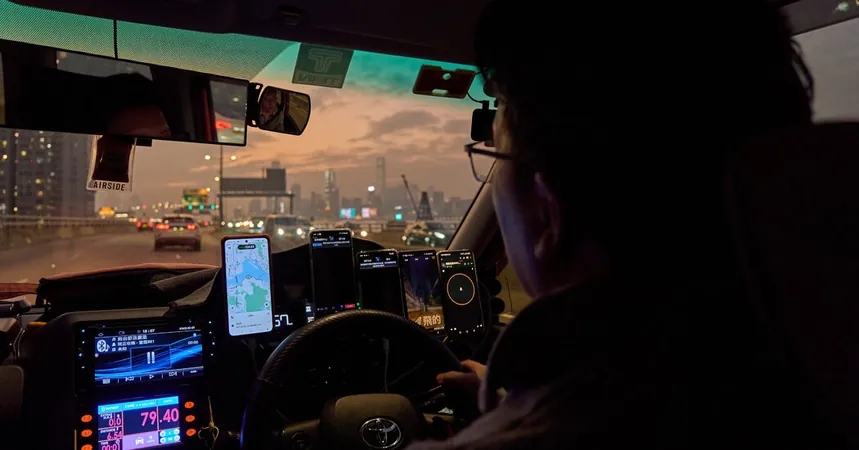
The End of an Era for Hong Kong's Taxi Drivers: A Service Under Pressure
2025-01-05
Author: Yan
The Iconic Red Taxi Cabs of Hong Kong
In the bustling city of Hong Kong, the iconic red taxi cabs have long been synonymous with the fast-paced lifestyle of its residents. However, as the sun sets over the busy streets of Prince Edward, the traditional image of taxi drivers is facing a significant transformation.
Drivers' Struggles Amid Change
On a quiet corner of the city, a group of aging taxi drivers congregate, discussing their struggles and the changing landscape of their industry. The afternoon handover signals the exchange between day and night shift drivers, a ritual that has remained unchanged despite the world around them. Yet, the harmony of this daily routine is now under threat from growing passenger dissatisfaction and government reform.
The Burden of Tradition
Historically, many taxi drivers in Hong Kong have cultivated a reputation for their grumpy demeanor and reckless driving – a reflection of the high-pressure environment they operate in. Passengers often face the challenge of paying cash, a quirky norm that leaves many visitors surprised and frustrated at the airport taxi ranks, while complaints about driver behavior have surged.
Government Intervention
In response to growing concerns and a push to revitalize tourism, the Hong Kong government has unveiled measures to address these issues. This summer, officials launched a campaign urging drivers to adopt more courteous behavior, targeting disruptive practices such as overcharging. Recently proposed regulations aim to make credit card and digital payment acceptance mandatory for all taxis by the end of 2025, along with the installation of surveillance cameras by 2026. This has ignited resistance among many drivers who see it as an invasion of privacy and an unnecessary burden.
Voices of Resistance
Veteran cab driver Lau Bing-kwan, now 75, expresses frustration at the government's growing control. "Would you want to be monitored all the time?" he questions, echoing a sentiment shared by many in his profession. The reluctance to embrace technological advancement stands as a symbol of resistance to change, but this inertia may prove costly.
The Chaotic Experience
As Hong Kong's public transport options continue to evolve with the times, taxi drivers’ experiences often stand in stark contrast. In a city where high-speed trains and reliable buses dominate, rides in a taxi can feel chaotic. From the moment a passenger enters a taxi, they can expect a fast ride through narrow streets, often accompanied by the driver’s preoccupation with their smartphones – whether for navigation or personal interests such as horse racing.
Economic Pressures
Economic pressures compound these realities. Following a downturn sparked by the COVID-19 pandemic and disruptions from mainland China's economic slowdown, many taxi drivers are scrambling to make ends meet. Operating costs like rental fees for licenses, which have plummeted to two-thirds of their peak value, are squeezing drivers further. With existing drivers aging and few young people entering the trade, the industry is at a tipping point.
The Aging Workforce
The current situation encapsulates a broader issue: the aging population of taxi drivers, many of whom cannot afford retirement. Struggling with rising operational costs and low profit margins, drivers like Lau Man-hung, 63, work grueling hours, often sacrificing basic needs such as meals and breaks, just to secure a meager income.
Adapting to Change
In the face of these challenges, some drivers are adapting. Joe Fong, 45, has embraced change by diversifying his work as both an Uber driver and a taxi operator. He champions electronic payment systems and is open to the installation of security cameras, aligning with the growing trend of technological integration in transportation.
The Connection Between Drivers and Passengers
Yet, despite the growing division between tradition and modernization, there remains an inherent connection between taxi drivers and their passengers. As Fong sums it up, "You need a ride and I need your money," highlighting a shared dependency that continues to underpin the taxi industry in Hong Kong.
The Future of Taxi Driving in Hong Kong
As the government pushes for modernization, the future of taxi driving in Hong Kong hangs in the balance. Will the iconic red cab pass into history, or will the industry find a way to evolve while preserving its unique cultural identity? The answer lies in the hands of both the drivers and the city they serve.


 Brasil (PT)
Brasil (PT)
 Canada (EN)
Canada (EN)
 Chile (ES)
Chile (ES)
 Česko (CS)
Česko (CS)
 대한민국 (KO)
대한민국 (KO)
 España (ES)
España (ES)
 France (FR)
France (FR)
 Hong Kong (EN)
Hong Kong (EN)
 Italia (IT)
Italia (IT)
 日本 (JA)
日本 (JA)
 Magyarország (HU)
Magyarország (HU)
 Norge (NO)
Norge (NO)
 Polska (PL)
Polska (PL)
 Schweiz (DE)
Schweiz (DE)
 Singapore (EN)
Singapore (EN)
 Sverige (SV)
Sverige (SV)
 Suomi (FI)
Suomi (FI)
 Türkiye (TR)
Türkiye (TR)
 الإمارات العربية المتحدة (AR)
الإمارات العربية المتحدة (AR)